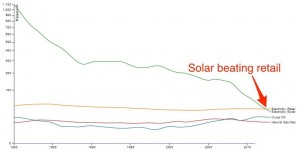We’ve seen a lot of hype about the growth of solar in recent years and how it’s expected to be the dominant source of energy by 2030.
Just in case you’ve been hiding under a rock for the last few years and haven’t been tracking the exponential growth that solar has been having, here’s a small recap:
In the last 10 years, solar has experienced an explosive annual growth in installed capacity of 51%.
It has been doubling every 2 years and has been for the last 20 years. In 2012, solar supplied 0.5% of the world’s global electricity needs. Currently, solar supplies about 2%.
If solar keeps this growth, we’re only 12 years away (or six doublings) from supplying 100% of our energy needs with solar.
According to Deutsche Bank, solar will be the dominant global electricity source by 2030.
So, the question is: can solar keep this growth curve and actually dominate the energy market in the near future?
The answer is simple: it can and it should.
In fact, it might even accelerate.
Why? If it doesn’t, we’re going to get fried, literally.
A report published recently stated that if we want to keep this planet from heating more than 2C, we can’t burn more fossil fuels. No more of our electricity can come from fossil fuels. They have to stay in the ground. We can’t burn them.
So, if we actually want live on this planet and leave it in habitable conditions for future generations, this has to happen. Solar and renewables have to dominate the electricity production panorama in the next 10-20 years. There’s no doubt about it.
So, why might solar’s growth actually accelerate?
When technologies reach a certain point, the point of critical mass, their growth actually accelerates. There are several theories that back this up.
The law of diffusion of innovations
This law states explains how, why and at what rate new ideas and technologies spread. It states that when 15% of people accept an innovation, it will quickly spread to 60% of the target population.
The law of the few
This one states that when 10% of the population holds an unshakable belief, the majority of society will adopt their belief. Once this key type of people champion an idea, it will spread throughout society.
If these laws are true, solar is on the brink of mass adoption. Let’s take the US for example.
According to Greentech Media, the US has 9 million households that are ideal for solar. Earlier this year, the US reached the milestone of 1 million solar systems nationwide (11%). This is no small feat, it took about 40 years to achieve, and now the US is expected to reach the 2 million mark by 2018, in just 2 years.
Right now a solar system is installed in the US every 2.5 minutes.
Sounds like accelerating growth, right?
Crossing the Chasm
There is just one little caveat. To actually jump from the early adopters of new technologies and innovations to mass market, there is a chasm that needs to be crossed.
At the end of the day, the acceptance of solar in any market is influenced by a set of artificial variables; including public policy, market regulations, and incentives. This makes each and every market unique. Therefore, these laws might not apply to the market as a whole, YET.
The Tipping Point For Solar
There is one aspect of solar that will change this dynamic. Once we cross this point, no one will be able to stop mass adoption. The point I’m talking about is grid parity.
Grid parity is the point in which solar, or any other type of alternative energy source, can produce electricity at the same price from the electricity grid (your utility).
Grid parity by itself doesn’t offer much incentive for the mass market to adopt solar. But once we go beyond grid parity, the story changes. Once solar electricity is cheaper than electricity from the grid, the reasons not to go solar are harder to find.
The good news is that this is already happening. The cost of electricity from solar is now cheaper than retail electricity for a growing number of people.
So, brace yourselves, as solar electricity prices keep on falling, we’re going to see mass adoption of solar at accelerating rates.






